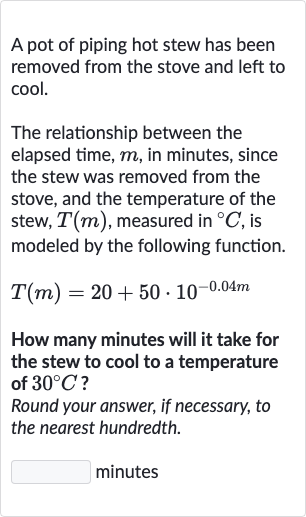AI tutor
Welcome to Bytelearn!
Let’s check out your problem:

A pot of piping hot stew has been removed from the stove and left to cool.The relationship between the elapsed time, , in minutes, since the stew was removed from the stove, and the temperature of the stew, , measured in , is modeled by the following function.How many minutes will it take for the stew to cool to a temperature of ?Round your answer, if necessary, to the nearest hundredth. minutes
Full solution
Q. A pot of piping hot stew has been removed from the stove and left to cool.The relationship between the elapsed time, , in minutes, since the stew was removed from the stove, and the temperature of the stew, , measured in , is modeled by the following function.How many minutes will it take for the stew to cool to a temperature of ?Round your answer, if necessary, to the nearest hundredth. minutes
- Understand and Set up Equation: Understand the problem and set up the equation.We are given the temperature function , where is the temperature of the stew in degrees Celsius after minutes. We need to find the value of when .Set up the equation: .
- Isolate Exponential Term: Isolate the exponential part of the equation.Subtract from both sides of the equation to isolate the exponential term.
- Divide to Solve Exponential Term: Divide both sides by to solve for the exponential term.
- Take Logarithm to Solve for : Take the logarithm of both sides to solve for . Use the property of logarithms that . Since is , we can simplify this to:
- Solve for m: Solve for m.Divide both sides by to isolate .Calculate the value of using a calculator.
More problems from Interpret parts of quadratic expressions: word problems
QuestionGet tutor help
QuestionGet tutor help
QuestionGet tutor help
QuestionGet tutor help
QuestionGet tutor help
QuestionGet tutor help
QuestionGet tutor help
QuestionGet tutor help
